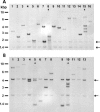Functional genomics of eukaryotic photosynthesis using insertional mutagenesis of Chlamydomonas reinhardtii
- PMID: 15653810
- PMCID: PMC1065355
- DOI: 10.1104/pp.104.055244
Functional genomics of eukaryotic photosynthesis using insertional mutagenesis of Chlamydomonas reinhardtii
Abstract
The unicellular green alga Chlamydomonas reinhardtii is a widely used model organism for studies of oxygenic photosynthesis in eukaryotes. Here we describe the development of a resource for functional genomics of photosynthesis using insertional mutagenesis of the Chlamydomonas nuclear genome. Chlamydomonas cells were transformed with either of two plasmids conferring zeocin resistance, and insertional mutants were selected in the dark on acetate-containing medium to recover light-sensitive and nonphotosynthetic mutants. The population of insertional mutants was subjected to a battery of primary and secondary phenotypic screens to identify photosynthesis-related mutants that were pigment deficient, light sensitive, nonphotosynthetic, or hypersensitive to reactive oxygen species. Approximately 9% of the insertional mutants exhibited 1 or more of these phenotypes. Molecular analysis showed that each mutant line contains an average of 1.4 insertions, and genetic analysis indicated that approximately 50% of the mutations are tagged by the transforming DNA. Flanking DNA was isolated from the mutants, and sequence data for the insertion sites in 50 mutants are presented and discussed.
Figures




Similar articles
-
Large-scale insertional mutagenesis of Chlamydomonas supports phylogenomic functional prediction of photosynthetic genes and analysis of classical acetate-requiring mutants.Plant J. 2015 Apr;82(2):337-51. doi: 10.1111/tpj.12806. Plant J. 2015. PMID: 25711437
-
Insertional mutagenesis as a tool to study genes/functions in Chlamydomonas.Adv Exp Med Biol. 2007;616:77-89. doi: 10.1007/978-0-387-75532-8_7. Adv Exp Med Biol. 2007. PMID: 18161492 Review.
-
Nuclear mutants of Chlamydomonas reinhardtii defective in the biogenesis of the cytochrome b6f complex.Plant Mol Biol. 1995 Dec;29(5):921-32. doi: 10.1007/BF00014966. Plant Mol Biol. 1995. PMID: 8555456
-
tla1, a DNA insertional transformant of the green alga Chlamydomonas reinhardtii with a truncated light-harvesting chlorophyll antenna size.Planta. 2003 May;217(1):49-59. doi: 10.1007/s00425-002-0968-1. Epub 2003 Feb 12. Planta. 2003. PMID: 12721848
-
Functional genomics of plant photosynthesis in the fast lane using Chlamydomonas reinhardtii.Trends Plant Sci. 2001 Aug;6(8):364-71. doi: 10.1016/s1360-1385(01)02018-0. Trends Plant Sci. 2001. PMID: 11495790 Review.
Cited by
-
Novel thylakoid membrane GreenCut protein CPLD38 impacts accumulation of the cytochrome b6f complex and associated regulatory processes.J Biol Chem. 2013 Mar 8;288(10):7024-36. doi: 10.1074/jbc.M112.427476. Epub 2013 Jan 9. J Biol Chem. 2013. PMID: 23303190 Free PMC article.
-
Fermentation metabolism and its evolution in algae.Front Plant Sci. 2013 May 22;4:150. doi: 10.3389/fpls.2013.00150. eCollection 2013. Front Plant Sci. 2013. PMID: 23734158 Free PMC article.
-
Retrograde bilin signaling enables Chlamydomonas greening and phototrophic survival.Proc Natl Acad Sci U S A. 2013 Feb 26;110(9):3621-6. doi: 10.1073/pnas.1222375110. Epub 2013 Jan 23. Proc Natl Acad Sci U S A. 2013. PMID: 23345435 Free PMC article.
-
Phylogenetic engineering at an interface between large and small subunits imparts land-plant kinetic properties to algal Rubisco.Proc Natl Acad Sci U S A. 2005 Nov 22;102(47):17225-30. doi: 10.1073/pnas.0508042102. Epub 2005 Nov 10. Proc Natl Acad Sci U S A. 2005. PMID: 16282373 Free PMC article.
-
Acclimation to singlet oxygen stress in Chlamydomonas reinhardtii.Eukaryot Cell. 2007 Jun;6(6):919-30. doi: 10.1128/EC.00207-06. Epub 2007 Apr 13. Eukaryot Cell. 2007. PMID: 17435007 Free PMC article.
References
-
- Alonso JM, Stepanova AN, Leisse TJ, Kim CJ, Chen HM, Shinn P, Stevenson DK, Zimmerman J, Barajas P, Cheuk R, et al (2003) Genome-wide insertional mutagenesis of Arabidopsis thaliana. Science 301: 653–657 - PubMed
-
- Asamizu E, Nakmura Y, Sato S, Fukuzawa H, Tabata S (1999) A large scale structural analysis of cDNAs in a unicellular green alga, Chlamydomonas reinhardtii. I. Generation of 3433 non-redundant expressed sequence tags. DNA Res 6: 369–373 - PubMed
-
- Barakat A, Gallois P, Raynal M, Mestre-Ortega D, Sallaud C, Guiderdoni E, Delseny M, Bernardi G (2000) The distribution of T-DNA in the genomes of transgenic Arabidopsis and rice. FEBS Lett 471: 161–164 - PubMed
-
- Chen SY, Jin WZ, Wang MY, Zhang F, Zhou J, Jia OJ, Wu YR, Liu FY, Wu P (2003) Distribution and characterization of over 1000 T-DNA tags in rice genome. Plant J 36: 105–113 - PubMed
-
- Clarke L, Carbon J (1976) A colony bank containing synthetic Col-E-1 hybrid plasmids representative of the entire Escherichia coli genome. Cell 9: 91–99 - PubMed
Publication types
MeSH terms
LinkOut - more resources
Full Text Sources
Other Literature Sources

